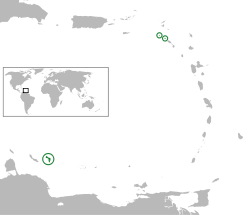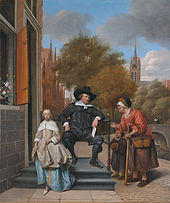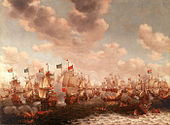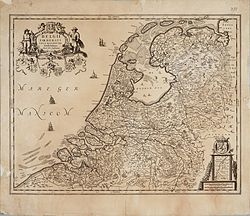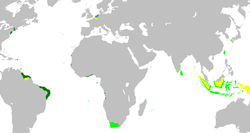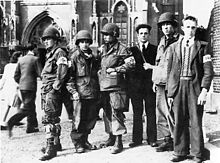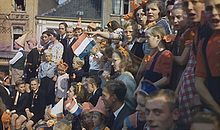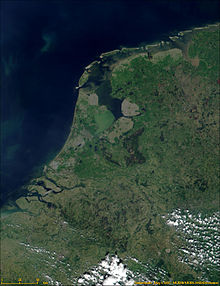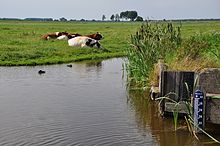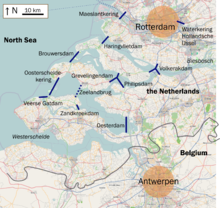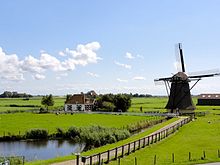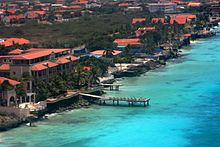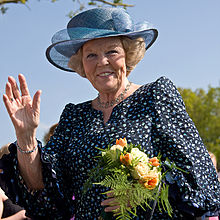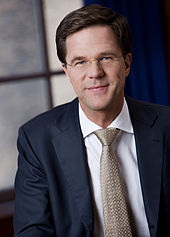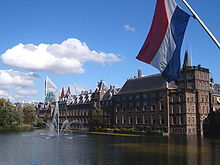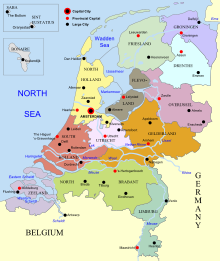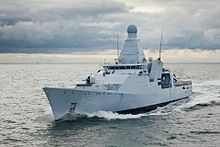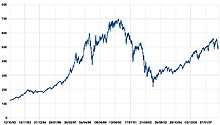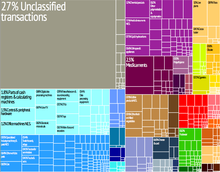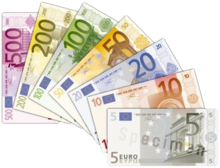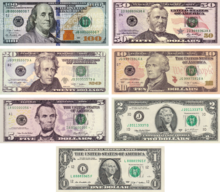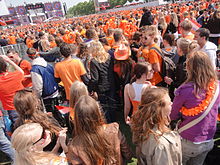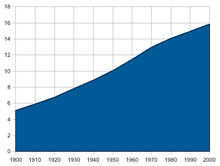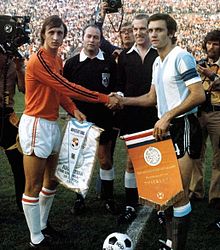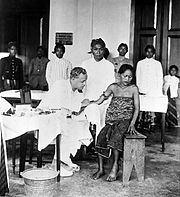
Netherlands
Background to the schools Wikipedia
SOS Children made this Wikipedia selection alongside other schools resources. Sponsor a child to make a real difference.
| Netherlands Nederland
|
||||||
|---|---|---|---|---|---|---|
|
||||||
| Motto: "Je maintiendrai" (French) "Ik zal handhaven" (Dutch) "I will hold firm" a |
||||||
| Anthem: Het Wilhelmus | ||||||
|
Location of the Netherlands (dark green)
– in Europe (light green & dark grey) |
||||||
|
Location of the special municipalities of the Netherlands (green and circled)
in the Caribbean (grey) |
||||||
| Capital and largest city |
Amsterdamc 52°22′N 4°53′E |
|||||
| Official languages | Dutch | |||||
| Recognised regional languagesb |
|
|||||
| Ethnic groups (2012) |
|
|||||
| Demonym | Dutch | |||||
| Government | Unitary parliamentary representative democracy under constitutional monarchy | |||||
| - | Monarch | Beatrix | ||||
| - | Prime Minister | Mark Rutte | ||||
| Legislature | States-General | |||||
| - | Upper house | Senate | ||||
| - | Lower house | House of Representatives | ||||
| Independence from the Spanish Empire | ||||||
| - | Dutch Republic | 26 July 1581 ( declared) | ||||
| - | Dutch Republic | 30 January 1648 ( recognised) | ||||
| - | Batavian Republic | 16 January 1795 | ||||
| - | Kingdom of the Netherlands | 1815 (Waterloo aftermath) | ||||
| Area | ||||||
| - | Total | 41,543 km2 ( 135th) 16,039 sq mi |
||||
| - | Water (%) | 18.41 | ||||
| Population | ||||||
| - | 2013 estimate | 16,751,323 ( 61st) | ||||
| - | Density | 405.7/km2 ( 24th) 1,050.7/sq mi |
||||
| GDP ( PPP) | 2011 estimate | |||||
| - | Total | $704.034 billion | ||||
| - | Per capita | $42,183 | ||||
| GDP (nominal) | 2011 estimate | |||||
| - | Total | $840.433 billion | ||||
| - | Per capita | $50,355 | ||||
| Gini (2007) | 30.9 medium |
|||||
| HDI (2013) | very high · 4th |
|||||
| Currency |
|
|||||
| Time zone | CET / AST ( UTC+1 / −4) | |||||
| - | Summer ( DST) | CEST / AST ( UTC+2 / −4) | ||||
| Drives on the | right | |||||
| Calling code |
|
|||||
| ISO 3166 code | NL | |||||
| Internet TLD | .nl f | |||||
| a. | ^ The official motto is in French. The literal translation into English is "I will maintain"; a better translation, however, is "I will hold firm" or "I will uphold" (namely, the integrity and independence of the territory). | |||||
| b. | ^ Frisian ( Friesland), Papiamento ( Bonaire) and English ( Sint Eustatius and Saba) have a formal status in certain parts of the country. Dutch Low Saxon and Limburgish are recognised as regional languages by the European Charter for Regional or Minority Languages. | |||||
| c. | ^ While Amsterdam is the constitutional capital, The Hague is the seat of the government. | |||||
| d. | ^ The euro is used in the European Netherlands and replaced the Dutch guilder in 2002. The U.S. dollar is used in the Caribbean Netherlands and replaced the Netherlands Antillean guilder in 2011. | |||||
| e. | ^ 599 was the country code designated for the now dissolved Netherlands Antilles. The Caribbean Netherlands still use 599-7 (Bonaire), 599-3 (Sint Eustatius) and 599-4 (Saba). | |||||
| f. | ^ The .eu domain is also used, as it is shared with other European Union member states. | |||||
The Netherlands ( / ˈ n ɛ ð ər l ə n d z /; Dutch: Nederland [ˈneːdərˌlɑnt]) is a constituent country of the Kingdom of the Netherlands, consisting of twelve provinces in North-West Europe and three islands in the Caribbean. The European part of the Netherlands borders the North Sea to the north and west, Belgium to the south, and Germany to the east, and shares maritime borders with Belgium, Germany and the United Kingdom. It is a parliamentary democracy organised as a unitary state. The country capital is Amsterdam and the seat of government is The Hague. The Netherlands in its entirety is often referred to as " Holland", although North and South Holland are actually only two of its provinces.
The Netherlands is a geographically low-lying country, with about 20% of its area and 21% of its population located below sea level, and 50% of its land lying less than one metre above sea level. This distinct feature contributes to the country's name: in Dutch (Nederland), English, and in many other European languages, its name literally means "(The) Low Countries" or "Low Country". Most of the areas below sea level are man-made, caused by centuries of extensive and poorly controlled peat extraction, lowering the surface by several meters. Even in flooded areas peat extraction continued through turf dredging. From the late 16th century land reclamation started and large polder areas are now preserved through elaborate drainage systems with dikes, canals and pumping stations. Much of the Netherlands is formed by the estuary of three important European rivers, which together with their distributaries form the Rhine-Meuse-Scheldt delta. Most of the country is very flat, with the exception of foothills in the far southeast and several low hill ranges in the central parts.
The Netherlands was one of the first countries to have an elected parliament, and the country is a founding member of the EU, NATO, OECD and WTO. Together with Belgium and Luxembourg it forms the Benelux economic union. The Netherlands had the tenth-highest per capita income in the world in 2011. The country is host to the Organization for the Prohibition of Chemical Weapons and five international courts: the Permanent Court of Arbitration, the International Court of Justice, the International Criminal Tribunal for the Former Yugoslavia, the International Criminal Court and the Special Tribunal for Lebanon. The first four are situated in The Hague, as is the EU's criminal intelligence agency Europol and judicial co-operation agency Eurojust. This has led to the city being dubbed "the world's legal capital". The Netherlands has a market-based mixed economy, ranking 13th of 157 countries according to the Index of Economic Freedom. In May 2011, the Netherlands was ranked as the "happiest" country according to results published by the OECD.
History
Habsburg Netherlands 1519–1581

Under Charles V, Holy Roman Emperor and King of Spain, the Netherlands region was part of the Seventeen Provinces, which also included most of present-day Belgium, Luxembourg, and some land in France and Germany.
The Eighty Years' War between the provinces and Spain began in 1568. In 1579, the northern half of the Seventeen Provinces formed the Union of Utrecht, a treaty in which they promised to support each other in their defence against the Spanish army. The Union of Utrecht is seen as the foundation of the modern Netherlands. In 1581 the northern provinces adopted the Act of Abjuration, the declaration of independence in which the provinces officially deposed Philip II of Spain as reigning monarch in the northern provinces.
Queen Elizabeth I of England sympathised with the Dutch struggle against the Spanish, and in 1585 she concluded a treaty with the Dutch whereby she promised to send an English army to the Netherlands to aid the Dutch in their war with the Spanish. In December 1585, 7,600 soldiers were sent to the Netherlands from England under the command of Robert Dudley, 1st Earl of Leicester. However, the English army was of no real benefit to the Dutch rebellion.
Although Robert Dudley returned to the Netherlands in November 1586 with another army, the army still had little effect in the rebellion. Philip II, the son of Charles V, was not prepared to let them go easily, and war continued until 1648, when Spain under King Philip IV finally recognised the independence of the seven northwestern provinces in the Peace of Münster. Parts of the southern provinces became de facto colonies of the new republican-mercantile empire.
Dutch Republic 1581–1795
After independence, the provinces of Holland, Zeeland, Groningen, Friesland, Utrecht, Overijssel, and Gelderland formed a confederation. All these provinces were autonomous and had their own government, the "States of the Province". The States-General, the confederal government, were seated in The Hague and consisted of representatives from each of the seven provinces. The sparsely populated region of Drenthe, mainly consisting of poor peatland, was part of the republic too, although Drenthe was not considered one of the provinces; it had its own States, but the landdrost of Drenthe was appointed by the States-General. Moreover, the Republic had come to occupy during the Eighty Years' War a number of so-called Generality Lands (Generaliteitslanden in Dutch). These territories were governed directly by the States-General. They did not have a governmental structure of their own and did not have representatives in the States-General. Their population was mainly Roman Catholic, and these areas were used as a buffer zone between the Republic and the Southern Netherlands.
The Dutch Empire grew to become one of the major seafaring and economic powers of the 17th century. In the Dutch Golden Age ("Gouden Eeuw"), colonies and trading posts were established all over the world. Dutch settlement in North America began with the founding of New Amsterdam, on the southern part of Manhattan in 1614. In South Africa, the Dutch settled the Cape Colony in 1652. By 1650, the Dutch owned 16,000 merchant ships. During the 17th century, the Dutch population increased from an estimated 1.5 million to almost 2 million.
Many economic historians regard the Netherlands as the first thoroughly capitalist country in the world. In early modern Europe it featured the wealthiest trading city (Amsterdam) and the first full-time stock exchange. The inventiveness of the traders led to insurance and retirement funds as well as phenomena such as the boom-bust cycle, the world's first asset-inflation bubble, the tulip mania of 1636–1637, and, according to Murray Sayle, the world's first bear raider, Isaac le Maire, who forced prices down by dumping stock and then buying it back at a discount. The republic went into a state of general decline in the later 18th century, with economic competition from England and long standing rivalries between the two main factions in Dutch society, the Staatsgezinden (Republicans) and the Prinsgezinden (Royalists or Orangists) as main factors.
In the 17th century, plantation colonies were established by the Dutch and English along the many rivers in the fertile Guyana plains. The earliest documented colony in Guiana was along the Suriname River and called Marshall's Creek. The area was named after an Englishman. Disputes arose between the Dutch and the English. In 1667, the Dutch decided to keep the nascent plantation colony of Suriname conquered from the English, resulting from the Treaty of Breda. The English were left with New Amsterdam, a small trading post in North America, which is now known as New York City.
French Influence 1795–1814
On 19 January 1795, one day after stadtholder William V of Orange fled to England, the Bataafse Republiek ( Batavian Republic) was proclaimed, rendering the Netherlands a unitary state. From 1795 to 1806, the Batavian Republic designated the Netherlands as a republic modelled after the French Republic.
From 1806 to 1810, the Koninkrijk Holland ( Kingdom of Holland) was set up by Napoleon Bonaparte as a puppet kingdom governed by his brother Louis Bonaparte in order to control the Netherlands more effectively. The name of the leading province, Holland, was used for the whole country. The Kingdom of Holland covered the area of the present day Netherlands, with the exception of Limburg and parts of Zeeland, which were French territory. In 1807, Prussian East Frisia and Jever were added to the kingdom. In 1809, however, after a failed British invasion, Holland had to give over all territories south of the Rhine to France.
King Louis Bonaparte did not meet Napoleon's expectations – he tried to serve Dutch interests instead of his brother's, allowed trade with the British in spite of the Continental System and even tried to learn Dutch – and he was forced to abdicate on 1 July 1810. He was succeeded by his five-year-old son Napoleon Louis Bonaparte. Napoleon Louis reigned as Louis II for just ten days as Napoleon ignored his young nephew’s accession to the throne. The Emperor sent in an army to invade the country and dissolved the Kingdom of Holland. The Netherlands then became part of the French Empire.
The Netherlands remained part of the French Empire until the autumn of 1813, when Napoleon was defeated in the Battle of Leipzig and forced to withdraw his troops from the country.
Kingdom of the Netherlands 1815–1940
|
A map of the Dutch colonial empire. Light green: territories administered by or originating from territories administered by the Dutch East India Company; dark green: the Dutch West India Company.
|
William Frederick, son of the last stadtholder, returned to the Netherlands in 1813 at the invitation of the provisional government formed after the withdrawal of the French. Although it comprised mostly the same men who had driven out his father 18 years earlier, all parties agreed that William was the only choice to head any new government. On 6 December, he proclaimed himself Sovereign Prince of the Netherlands. On 16 March 1815, the Sovereign Prince raised the Netherlands to the status of a kingdom and proclaimed himself William I.
In 1815, the Congress of Vienna formed the United Kingdom of the Netherlands by adding the southern Netherlands to the north in order to create a strong country on the northern border of France. In addition, William became hereditary Grand Duke of Luxembourg. The Congress of Vienna gave Luxembourg to William as personal property in exchange for his German possessions, Nassau-Dillenburg, Siegen, Hadamar, and Diez.
However, the south had been culturally separate from the north since 1581, and rebelled against William's attempt to create a single culture. The south rebelled and gained independence in 1830 as Belgium, while the personal union between Luxembourg and the Netherlands was severed in 1890, when William III died with no surviving male heirs. Ascendancy laws prevented his daughter Queen Wilhelmina from becoming the next Grand Duchess. Therefore the throne of Luxembourg passed over from the House of Orange-Nassau to the House of Nassau-Weilburg, a junior branch of the House of Nassau.
The largest Dutch settlement abroad was the Cape Colony. It was established by Jan van Riebeeck on behalf of the Dutch East India Company at Cape Town (Dutch: Kaapstad) in 1652. The Prince of Orange acquiesced to British occupation and control of the Cape Colony in 1788. The Netherlands also possessed several other colonies, but Dutch settlement in these lands was limited. Most notable were the vast Dutch East Indies (now Indonesia) and the Colony of Surinam (now Suriname). These 'colonies' were first administered by the Dutch East India Company and the Dutch West India Company, both collective private enterprises. Three centuries later these companies got into financial trouble, and the territories in which they operated were taken over by the Dutch government (in 1815 and 1791 respectively). Only then did they become official colonies.
During its colonial period the Netherlands was heavily involved in the slave trade. The Dutch planters relied heavily on African slaves to cultivate the coffee, cocoa, sugar cane and cotton plantations along the rivers. Treatment of the slaves by their owners was notoriously bad, and many slaves escaped the plantations. Slavery was abolished by the Netherlands in Dutch Guiana and Curaçao and Dependencies in 1863, but the slaves were not fully released until 1873, after a mandatory 10 year transition period during which time they were required to work on the plantations for minimal pay and without state sanctioned torture. As soon as they became truly free, the slaves largely abandoned the plantations where they had suffered for several generations in favour of the city Paramaribo. Every year this is remembered during Keti Koti, 1 July, Emancipation Day (end of slavery).
During the 19th century, the Netherlands was slow to industrialize compared to neighbouring countries, mainly because of the great complexity involved in modernizing the infrastructure, consisting largely of waterways, and the great reliance its industry had on windpower.
Although the Netherlands remained neutral during World War I, it was heavily involved in the war. German general Count Schlieffen, who was Chief of the Imperial German General Staff had originally planned to invade the Netherlands while advancing into France in the original Schlieffen Plan. This was changed by Schlieffen's successor Helmuth von Moltke the Younger in order to maintain Dutch neutrality. Later during the war Dutch neutrality proved essential to German survival until the blockade by Great Britain in 1916, when the import of goods through the Netherlands was no longer possible. However, the Dutch were able to continue to remain neutral during the war using their diplomacy and their ability to trade.
Second World War 1940–1945
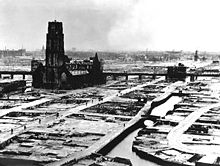
The Netherlands intended to remain neutral during the Second World War, although contingency plans involving the armies of Belgium, France and the United Kingdom were drawn up in case of German aggression. Despite this neutrality, Nazi Germany invaded the Netherlands on 10 May 1940 as part of their campaign against the Allied forces. French forces in the south and British ships in the west came to help but turned around quickly, evacuating many civilians and several thousand German prisoners of war from the German elite airborne divisions.
The country was overrun in five days. Only after (but not because of) the bombing of Rotterdam, the main element of the Dutch army surrendered on 14 May 1940, although a Dutch and French force held the western part of Zeeland for some time after the surrender. The Kingdom as such, continued the war from the colonial empire; the government in exile resided in London.
During the occupation, over 100,000 Dutch Jews were rounded up to be transported to Nazi German concentration camps in Germany, German-occupied Poland and German-occupied Czechoslovakia. By the time these camps were liberated, only few Dutch Jews survived. Dutch workers were conscripted for forced labour in German factories, civilians were killed in reprisal for attacks on German soldiers, and the countryside was plundered for food for German soldiers in the Netherlands and for shipment to Germany. Although there were thousands of Dutch who risked their lives by hiding Jews from the Germans, as recounted in The Hiding Place by Corrie ten Boom and The Heart Has Reasons by Mark Klempner, there were also Dutch who collaborated with the occupying force in hunting down hiding Jews. Local fascists and anti-Bolsheviks joined the Waffen-SS in the 4th SS Volunteer Panzergrenadier Brigade Netherlands, fighting on the Eastern Front as well as other units. Racial restrictions were relaxed to the extent that even Asians from Dutch East Indies (Indonesia) units were recruited. Political collaborators were members of the fascist NSB, the only legal political party in the occupied Netherlands.
On 8 December 1941, the Netherlands declared war on Japan. The government-in-exile then lost control of its major colonial stronghold, the Netherlands East Indies (Indonesia), to Japanese forces in March 1942. " American-British-Dutch-Australian" (ABDA) forces fought hard in some instances but were overwhelmed. During the Japanese occupation of Indonesia, the Japanese interned Dutch civilians and used Dutch and Indos (Eurasians of Dutch and Indonesian descent) alike as forced labour, both in the Netherlands East Indies and in neighbouring countries. This included forcing women to work as " comfort women" (sex slaves) for Japanese personnel.
The Dutch Red Cross reported the deaths in Japanese custody of 14,800 European civilians out of 80,000 interned and 12,500 of the 34,000 POW captured. A later UN report stated that 4 million people died in Indonesia as a result of famine and forced labour (known as romusha) during the Japanese occupation. Some military personnel escaped to Australia and other Allied countries from where they carried on the fight against Japan. Soon after VE day, the Dutch fought a colonial war against the new republic of Indonesia.
Princess Juliana of the Netherlands, the only child of Queen Wilhelmina and heir to the throne, sought refuge in Ottawa, Canada, with her two daughters, Beatrix and Irene, during the war. During Princess Juliana’s stay in Canada, preparations were made for the birth of her third child. To ensure the Dutch citizenship of this royal baby, the Canadian Parliament passed a special law declaring Princess Juliana's suite at the Ottawa Civic Hospital “extraterritorial”.
On 19 January 1943, Princess Margriet was born. The day after Princess Margriet's birth, the Dutch flag was flown on the Peace Tower. This was the only time in history a foreign flag has waved above Canada’s Parliament Buildings. In 1944–45, the First Canadian Army, which included Canadian, British and Polish troops, was responsible for liberating much of the Netherlands from German occupation. The joyous "Canadian summer" that ensued after the liberation, forged deep and long-lasting bonds of friendship between the Netherlands and Canada (See Canada–Netherlands relations). In 1949, Dutch troops occupied an area of 69 km² of the British zone of occupied Germany and annexed it. At that time, these areas were inhabited by almost 10,000 people.
Recent history 1945–present
After the war, the Dutch economy prospered by leaving behind an era of neutrality and gaining closer ties with neighbouring states. The Netherlands was one of the founding members of the Benelux (Belgium, the Netherlands and Luxembourg) grouping, was among the twelve founding members of the North Atlantic Treaty Organisation (NATO), and was among the six founding members of the European Coal and Steel Community, which would evolve into the EEC ( Common Market) and later the European Union.
The 1960s and 1970s were a time of great social and cultural change, such as rapid ontzuiling (literally: depillarisation), a term that describes the decay of the old divisions along political and religious lines. Youths, and students in particular, rejected traditional mores and pushed for change in matters such as women's rights, sexuality, disarmament and environmental issues.
On 10 October 2010 the Netherlands Antilles—a former country of the Kingdom of the Netherlands in the Caribbean—was dissolved. Referendums were held on each island of the Netherlands Antilles between June 2000 and April 2005 to determine their future status. As a result the islands of Bonaire, Sint Eustatius and Saba (the BES islands) were to obtain closer ties with the Netherlands. This led to the incorporation of these three islands into the country of the Netherlands as special municipalities upon the dissolution of the Netherlands Antilles. The special municipalities are collectively known as the Caribbean Netherlands.
Geography of the Netherlands
European Netherlands
The European area of the Netherlands lies between latitudes 50° and 54° N, and longitudes 3° and 8° E.
The country is divided into two main parts by three large rivers, the Rhine (Rijn) and its main distributaries, the Waal and the Meuse (Maas). These rivers functioned as a natural barrier between earlier fiefdoms and hence created traditionally a cultural divide, as is evident in some phonetic traits that are recognizable north and south of these "Large Rivers" (de Grote Rivieren).
The southwestern part of the Netherlands is a river delta and two tributaries of the Scheldt (Westerschelde and Oosterschelde). There is only one significant branch of the Rhine, the IJssel river, discharging into the IJsselmeer, the former Zuiderzee ('southern sea'). This river also forms a linguistic divide: people to the east of this river speak Dutch Low Saxon dialects (except for the province of Friesland, which has its own language).
Floods
Over the centuries, the Dutch coastline has changed considerably as a result of human intervention and natural disasters. Most notable in terms of land loss is the 1134 storm, which created the archipelago of Zeeland in the southwest.
On 14 December 1287, St. Lucia's flood affected the Netherlands and Germany killing more than 50,000 people in one of the most destructive floods in recorded history. The St. Elizabeth flood of 1421 and the mismanagement in its aftermath destroyed a newly reclaimed polder, replacing it with the 72-square-kilometre (28 sq mi) Biesbosch tidal floodplains in the south-centre. The last major flood in the Netherlands took place in early February 1953, when a huge storm caused the collapse of several dikes in the southwest of the Netherlands. More than 1,800 people drowned in the ensuing inundations. The Dutch government subsequently decided on a large-scale program of public works (the " Delta Works") to protect the country against future flooding. The project took more than thirty years to complete.
The disasters were partially increased in severity through human influence. People had drained relatively high lying swampland to use it as farmland. This drainage caused the fertile peat to compress and the ground level to drop, whereby they would lower the water level to compensate for the drop in ground level, causing the underlying peat to compress even more. Due to the flooding, farming was difficult, which encouraged foreign trade, the result of which was that the Dutch were involved in world affairs since the early 14th/15th century. The flooding problem remains unsolvable to this day. Also, up until the 19th century peat was mined, dried, and used for fuel, further exacerbating the problem.
To guard against floods, a series of defences against the water were contrived. In the first millennium AD, villages and farmhouses were built on man-made hills called terps. Later, these terps were connected by dikes. In the 12th century, local government agencies called " waterschappen" (English "water bodies") or " hoogheemraadschappen" ("high home councils") started to appear, whose job it was to maintain the water level and to protect a region from floods. (These agencies exist to this day, performing the same function.) As the ground level dropped, the dikes by necessity grew and merged into an integrated system. By the 13th century, windmills had come into use in order to pump water out of areas below sea level. The windmills were later used to drain lakes, creating the famous polders.
In 1932, the Afsluitdijk (English "Closure Dike") was completed, blocking the former Zuiderzee (Southern Sea) from the North Sea and thus creating the IJsselmeer ( IJssel Lake). It became part of the larger Zuiderzee Works in which four polders totalling 2,500 square kilometres (965 sq mi) were reclaimed from the sea.
Additionally, the Netherlands is one of the countries that may suffer most from climate change. Not only is the rising sea a problem, but also erratic weather patterns may cause the rivers to overflow.
Delta Works
After the 1953 disaster, the Delta Works were constructed, a comprehensive set of civil works throughout the Dutch coast. The project started in 1958 and was largely completed in 1997 with the completion of the Maeslantkering. A main goal of the Delta project was to reduce the risk of flooding in South Holland and Zeeland to once per 10,000 years (compared to 1 per 4000 years for the rest of the country). This was achieved by raising 3,000 kilometers (1,864 mi) of outer sea-dykes and 10,000 kilometers (6,214 mi) of inner, canal, and river dikes, and by closing off the sea estuaries of the Zeeland province. New risk assessments occasionally show problems requiring additional Delta project dyke reinforcements. The Delta project is considered by the American Society of Civil Engineers as one of the seven wonders of the modern world.
It is anticipated that global warming in the 21st century will result in a rise in sea level which will overwhelm the measures the Netherlands has taken to control floods. The Room for the River project allows for periodic flooding of indefensible lands. In such regions residents have been removed to higher ground, some of which has been raised above anticipated flood levels.
Climate
The predominant wind direction in the Netherlands is southwest, which causes a moderate maritime climate, with cool summers and mild winters. This is especially the case in places within direct proximity of the Dutch coastline, which sometimes are over 10 °C (18 °F) warmer (in winter) or cooler (in summer) than places in the (south)east of the country.
The following tables are based on mean measurements by the KNMI weather station in De Bilt between 1981 and 2010:
| Climate data for De Bilt (1981–2010 averages), all KNMI locations (1901–2011 extremes), snowy days: (1971–2000 averages). | |||||||||||||
|---|---|---|---|---|---|---|---|---|---|---|---|---|---|
| Month | Jan | Feb | Mar | Apr | May | Jun | Jul | Aug | Sep | Oct | Nov | Dec | Year |
| Record high °C (°F) | 17.2 (63) |
20.4 (68.7) |
25.6 (78.1) |
32.2 (90) |
35.6 (96.1) |
38.4 (101.1) |
37.1 (98.8) |
38.6 (101.5) |
35.2 (95.4) |
30.1 (86.2) |
21.1 (70) |
17.8 (64) |
38.6 (101.5) |
| Average high °C (°F) | 5.6 (42.1) |
6.4 (43.5) |
10.0 (50) |
14.0 (57.2) |
18.0 (64.4) |
20.4 (68.7) |
22.8 (73) |
22.6 (72.7) |
19.1 (66.4) |
14.6 (58.3) |
9.6 (49.3) |
6.1 (43) |
14.1 (57.4) |
| Daily mean °C (°F) | 3.1 (37.6) |
3.3 (37.9) |
6.2 (43.2) |
9.2 (48.6) |
13.1 (55.6) |
15.6 (60.1) |
17.9 (64.2) |
17.5 (63.5) |
14.5 (58.1) |
10.7 (51.3) |
6.7 (44.1) |
3.7 (38.7) |
10.1 (50.2) |
| Average low °C (°F) | 0.3 (32.5) |
0.2 (32.4) |
2.3 (36.1) |
4.1 (39.4) |
7.8 (46) |
10.5 (50.9) |
12.8 (55) |
12.3 (54.1) |
9.9 (49.8) |
6.9 (44.4) |
3.6 (38.5) |
1.0 (33.8) |
6.0 (42.8) |
| Record low °C (°F) | −27.4 (−17.3) |
−26.8 (−16.2) |
−20.7 (−5.3) |
−9.4 (15.1) |
−5.4 (22.3) |
−1.2 (29.8) |
0.7 (33.3) |
1.3 (34.3) |
−3.7 (25.3) |
−8.5 (16.7) |
−14.4 (6.1) |
−22.3 (−8.1) |
−27.4 (−17.3) |
| Precipitation mm (inches) | 69.6 (2.74) |
55.8 (2.197) |
66.8 (2.63) |
42.3 (1.665) |
61.9 (2.437) |
65.6 (2.583) |
81.1 (3.193) |
72.9 (2.87) |
78.1 (3.075) |
82.8 (3.26) |
79.8 (3.142) |
75.8 (2.984) |
832.5 (32.776) |
| Avg. precipitation days (≥ 0.1 mm) | 17 | 14 | 17 | 13 | 14 | 14 | 14 | 14 | 15 | 16 | 18 | 17 | 184 |
| Avg. snowy days (≥ 0 cm) | 6 | 6 | 4 | 2 | 0 | – | – | – | – | 0 | 2 | 5 | 25 |
| % humidity | 87 | 84 | 81 | 75 | 75 | 76 | 77 | 79 | 84 | 86 | 89 | 89 | 82 |
| Mean monthly sunshine hours | 62.3 | 85.7 | 121.6 | 173.6 | 207.2 | 193.9 | 206.0 | 187.7 | 138.3 | 112.9 | 63.0 | 49.3 | 1,601.5 |
| Source: Knmi.nl | |||||||||||||
Ice days (maximum temperature below 0 °C) usually occur from December until February, with the occasional rare ice day prior to or after that period. Freezing days (minimum temperature below 0 °C) occur much more often, usually ranging from mid November to late March, but not rarely measured as early as mid October and as late as mid May. If one chooses the height of measurement to be 10 cm. above ground instead of 150 cm., one may even find such temperatures in the middle of the summer. On average, snow can occur from November to April, but sometimes occurs in May or October too; however, there has been no snow in April or May in recent years.
Warm days (maximum temperature above 20 °C) in De Bilt are usually found in April to October, but in some parts of the country these warm days can also occur in March, or even sometimes in November or February (usually not in De Bilt, however). Summer days (maximum temperature above 25 °C) are usually measured in De Bilt from May until September, tropical days (maximum temperature above 30 °C) are rare and usually occur only in June to August.
Precipitation throughout the year is distributed relatively equally each month. Summer and autumn months tend to gather a little more precipitation than the other months, mainly because of the intensity of the rainfall rather than the frequency of rain days (this is especially the case in summer, when lightning is also much more frequent).
The number of sunshine hours is affected by the fact that due to the geographical latitude, the length of the days varies between barely eight hours in December and nearly 17 hours in June.
Environment
The Netherlands has 20 national parks and hundreds of other nature reserves. Most are owned by Staatsbosbeheer and Natuurmonumenten and include lakes, heathland, woods, dunes and other habitats.
Phytogeographically, the Netherlands is shared between the Atlantic European and Central European provinces of the Circumboreal Region within the Boreal Kingdom. According to the World Wide Fund for Nature, the territory of the Netherlands belongs to the ecoregion of Atlantic mixed forests.
In 1871 the last old original natural woods (Beekbergerwoud) were cut down, and most woods today are planted monocultures of trees like Scots Pine and trees that are not native to the Netherlands. These woods were planted on anthropogenic heaths and sand-drifts (overgrazed heaths) ( Veluwe).
Caribbean islands
The Caribbean Netherlands form part of the Lesser Antilles. Within this island group,
- Bonaire is part of the ABC islands within the Leeward Antilles island chain off the Venezuelan coast. The Leeward Antilles have a mixed volcanic and coral origin.
- Saba and Sint Eustatius are part of the SSS islands. They are located east of Puerto Rico and the Virgin Islands. Although in the English language they are considered part of the Leeward Islands, French, Spanish, Dutch and the English spoken locally consider them part of the Windward Islands. The Windward Islands are all of volcanic origin and hilly, leaving little ground suitable for agriculture. The highest point is Mount Scenery, 870 metres (2,854 ft), on Saba (also the highest point in all the Kingdom of the Netherlands).
The islands of the Caribbean Netherlands enjoy a tropical climate with warm weather all year round. The Leeward Islands are warmer and drier than the Windward islands. In summer, the Windward Islands can be subject to hurricanes.
Politics
The Netherlands has been a constitutional monarchy since 1815 and a parliamentary democracy since 1848. The Netherlands is described as a consociational state. Dutch politics and governance are characterised by an effort to achieve broad consensus on important issues, within both the political community and society as a whole. In 2010, The Economist ranked the Netherlands as the 10th most democratic country in the world.
The monarch is the head of state, at present Queen Beatrix. On 28 January 2013 Queen Beatrix announced her abdication from the throne on 30 April 2013. Willem-Alexander, crownprince, will from that moment on be the King of the Netherlands. Constitutionally, the position is equipped with limited powers. The monarch can exert some influence during the formation of a new cabinet, where they serve as neutral arbiter between the political parties. Additionally, the king (the title queen has no constitutional significance) has the right to be briefed and consulted. Depending on the personality and qualities of the king and the ministers, the king might have influence beyond the power granted by the constitution.
In practice, the executive power is formed by the council of Ministers, the deliberative council of the Dutch cabinet. The cabinet consists usually of 13 to 16 ministers and a varying number of state secretaries. One to three ministers are ministers without portfolio. The head of government is the Prime Minister of the Netherlands, who often is the leader of the largest party of the coalition. In fact, this has been continuously the case since 1973. The Prime Minister is a primus inter pares, meaning he has no explicit powers beyond those of the other ministers. Currently, the Prime Minister is Mark Rutte.
The cabinet is responsible to the bicameral parliament, the States-General, which also has legislative powers. The 150 members of the House of Representatives, the Lower House, are elected in direct elections, which are held every four years or after the fall of the cabinet (by example: when one of the chambers carries a motion of no-confidence, the cabinet offers its resignation to the monarch). The States-Provincial are directly elected every four years as well. The members of the provincial assemblies elect the 75 members of the Senate, the upper house, which has less legislative powers, as it can merely reject laws, not propose or amend them.
Both trade unions and employers organisations are consulted beforehand in policymaking in the financial, economic and social areas. They meet regularly with government in the Social-Economic Council. This body advises government and its advice cannot be put aside easily.
The Netherlands has a long tradition of social tolerance. In the 18th century, while the Dutch Reformed Church was the state religion, Catholicism, other forms of Protestantism, such as Baptists and Lutherans, and Judaism were tolerated. In the late 19th century this Dutch tradition of religious tolerance transformed into a system of pillarisation, in which religious groups coexisted separately and only interacted at the level of government. This tradition of tolerance is linked to Dutch criminal justice policies on recreational drugs, prostitution, LGBT rights, euthanasia, and abortion, which are among the most liberal in the world.
Political parties
Due to the multi-party system, no single party has held a majority in parliament since the 19th century, and coalition cabinets had to be formed. Since suffrage became universal in 1919, the Dutch political system has been dominated by three families of political parties: the strongest family were the Christian democrats, currently represented by the Christian Democratic Appeal (CDA), second were the social democrats, of which the Labour Party (PvdA), and third were the liberals, of which the People's Party for Freedom and Democracy (VVD) is the main representative.
These parties cooperated in coalition cabinets in which the Christian democrats had always been a partner: so either a centre left coalition of the Christian democrats and social democrats was ruling or a centre right coalition of Christian democrats and liberals. In the 1970s, the party system became more volatile: the Christian democratic parties lost seats, while new parties became successful, such as the radical democrat and progressive liberal D66.
In the 1994 election, the CDA lost its dominant position. A " purple" cabinet was formed by VVD, D66, and PvdA. In the 2002 elections, this cabinet lost its majority, due to an increased support for the CDA and the rise of the right LPF, a new political party, around Pim Fortuyn, who was assassinated a week before the elections. A short-lived cabinet was formed by CDA, VVD, and LPF, which was led by CDA leader Jan Peter Balkenende. After the 2003 elections in which the LPF lost most of its seats, a cabinet was formed by CDA, VVD, and D66. The cabinet initiated an ambitious program of reforming the welfare state, the healthcare system, and the immigration policies.
In June 2006, the cabinet fell after D66 voted in favour of a motion of no confidence against minister of immigration and integration Rita Verdonk, who had instigated an investigation of the asylum procedure of VVD MP Ayaan Hirsi Ali. A caretaker cabinet was formed by CDA and VVD, and general elections were held on 22 November 2006. In these elections, the CDA remained the largest party and the Socialist Party made the largest gains. The formation of a new cabinet took three months, resulting in a coalition of CDA, PvdA, and ChristianUnion.
On 20 February 2010, the cabinet fell when the PvdA refused to prolong the involvement of the Dutch Army in Uruzgan, Afghanistan. Snap elections were held on 9 June 2010, with devastating results for the previously largest party, the CDA, which lost about half of its seats, resulting in 21 seats. The VVD became the largest party with 31 seats, closely followed by the PvdA with 30 seats. The big winner of the 2010 elections was Geert Wilders whose extreme-right wing PVV, the ideological successor to the LPF, more than doubled in number of seats. Negotiation talks for a new government resulted in a minority government VVD-led (a first) in coalition with CDA as of 14 October 2010. This unprecedented minority government was supported by PVV, but proved ultimately to be unstable, when on 21 April 2012, PVV-leader Wilders unexpectedly 'torpedoed seven weeks of austerity talks' on new austerity measures, paving the way for early elections.
VVD and PvdA were the big winners of the elections. Since 5 November 2012 they form the second Rutte cabinet.
Administrative divisions
The Netherlands is divided into twelve administrative regions, called provinces, each under a Governor, who is called Commissaris van de Koningin (Commissioner of the Queen), except for the province Limburg where the commissioner is called Governor (Governor). All provinces are divided into municipalities (gemeenten), 430 in total (13 March 2010).
The country is also subdivided in water districts, governed by a water board (waterschap or hoogheemraadschap), each having authority in matters concerning water management. As of 1 January 2005 there are 27. The creation of water boards actually pre-dates that of the nation itself, the first appearing in 1196. The Dutch water boards are among the oldest democratic entities in the world still in existence.
The administrative structure on the 3 BES islands, also known as the Caribbean Netherlands, is different. These islands have the status of openbare lichamen ( public bodies) and are generally referred to as special municipalities. They are not part of a province.
Provinces of the Netherlands
|
||||||||||||||||||||||||||||||||||||||||||||||||||||||||||||||||||||||||||||||||||||||||||||||||||
Special municipalities of the Netherlands
|
|||||||||||||||||||||||||||||||||||
Foreign relations
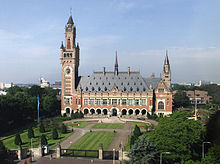
The history of Dutch foreign policy has been characterised by its neutrality. Since the Second World War the Netherlands has become a member of a large number of international organisations, most prominently the UN, NATO and the EU. The Dutch economy is very open and relies on international trade.
The foreign policy of the Netherlands is based on four basic commitments: to atlantic cooperation, to European integration, to international development and to international law. One of the more controversial international issues surrounding the Netherlands is its liberal policy towards soft drugs.
During and after the Dutch Golden Age, the Dutch people built up a commercial and colonial empire, which fell apart quickly after the Second World War. The historical ties inherited from its colonial past still influence the foreign relations of the Netherlands.
Military
The Netherlands has one of the oldest standing armies in Europe; it was first established as such by Maurice of Nassau. The Dutch army was used throughout the Dutch Empire. After the defeat of Napoleon, the Dutch army was transformed into a conscription army. The army was unsuccessfully deployed during the Belgian revolution in 1830. After 1830, it was deployed mainly in the Dutch colonies, as the Netherlands remained neutral in European wars (including World War I), until the Netherlands was invaded in World War II and quickly defeated by the Wehrmacht in May 1940.
The Netherlands abandoned its neutrality in 1948 when it signed the Treaty of Brussels, and later became a founding member of NATO in 1949. The Dutch military was therefore part of the NATO strength in Cold War Europe, deploying its army to several bases in Germany. In 1996 conscription was suspended, and the Dutch army was once again transformed into a professional army. Since the 1990s the Dutch army has been involved in the Bosnian War and the Kosovo War, it held a province in Iraq after the defeat of Saddam Hussein, and it was engaged in Afghanistan.
The military is composed of four branches, all of which carry the prefix Koninklijke (Royal):
- Koninklijke Landmacht (KL), the Royal Netherlands Army
- Koninklijke Marine (KM), the Royal Netherlands Navy, including the Naval Air Service and Marine Corps
- Koninklijke Luchtmacht (KLu), the Royal Netherlands Air Force
- Koninklijke Marechaussee (KMar), the Royal Military Police, tasks include military police and border control
General Tom Middendorp is the current Commander of the Netherlands armed forces. All military specialities except the submarine service and the Royal Netherlands Marine Corps (Korps Mariniers) are open to women. The Korps Commandotroepen, the Special Operations Force of the Netherlands Army, is open to women, but because of the extremely high physical demands for initial training, it is almost impossible for women to become a commando. The Dutch Ministry of Defence employs more than 70,000 personnel, including over 20,000 civilians and over 50,000 military personnel. In April 2011 the government announced a major reduction in its military due to a cut in government expenditure, including a decrease in the number of tanks, fighter aircraft, naval ships and senior officials.
Economy
The Netherlands has a developed economy and has been playing a special role in the European economy for many centuries. Since the 16th century, shipping, fishing, trade, and banking have been leading sectors of the Dutch economy. The Netherlands is one of the world's 10 leading exporting countries. Foodstuffs form the largest industrial sector. Other major industries include chemicals, metallurgy, machinery, electrical goods, and tourism. Examples include Unilever, Heineken, financial services ( ING), chemicals ( DSM), petroleum refining (Shell), electronical machinery ( Philips, ASML) and car navigation TomTom.
The Netherlands has the 17th largest economy in the world, and ranks 10th in GDP (nominal) per capita. Between 1997 and 2000 annual economic growth (GDP) averaged nearly 4%, well above the European average. Growth slowed considerably from 2001 to 2005 with the global economic slowdown, but accelerated to 4.1% in the third quarter of 2007. Inflation is 1.3%, and unemployment is at 4.0% of the labour force. By Eurostat standards, unemployment in the Netherlands is at 4.1% (April 2010) – the lowest rate of all European Union member states. But in Q3 and Q4 2011, the Dutch economy contracted by 0.4% and 0.7%, respectively due to European Debt Crisis, while in Q4 the Eurozone economy shrunk by 0.3%. The Netherlands also has a relatively low GINI coefficient of 0.326. Despite ranking only 7th in GDP per capita, UNICEF ranked the Netherlands 1st in child well-being. On the Index of Economic Freedom Netherlands is the 13th most free market capitalist economy out of 157 surveyed countries.
Amsterdam is the financial and business capital of the Netherlands. The Amsterdam Stock Exchange (AEX), part of Euronext, is the world's oldest stock exchange and is one of Europe's largest bourses. It is situated near Dam Square in the city's centre. As a founding member of the euro, the Netherlands replaced (for accounting purposes) its former currency, the "gulden" ( guilder), on 1 January 1999, along with 15 other adopters of the euro. Actual euro coins and banknotes followed on 1 January 2002. One euro was equivalent to 2.20371 Dutch guilders. However, in the Caribbean Netherlands, the U.S. dollar is used instead of the euro.
The Dutch location gives it prime access to markets in the UK and Germany, with the port of Rotterdam being the largest port in Europe. Other important parts of the economy are international trade (Dutch colonialism started with cooperative private enterprises such as the VOC), banking and transport. The Netherlands successfully addressed the issue of public finances and stagnating job growth long before its European partners. Amsterdam is the 5th busiest tourist destination in Europe with more than 4.2 million international visitors. Since the enlargement of the EU large numbers of migrant workers have arrived in the Netherlands from central and eastern Europe.
The country continues to be one of the leading European nations for attracting foreign direct investment and is one of the five largest investors in the United States. The economy experienced a slowdown in 2005, but in 2006 recovered to the fastest pace in six years on the back of increased exports and strong investment. The pace of job growth reached 10-year highs in 2007. The Netherlands moved up from the 11th position in the Global Competitiveness Index to the 9th position in 2007.
One of the largest natural gas fields in the world is situated near Slochteren. Exploitation of this field resulted in a total revenue of €159 billion since the mid-1970s. With just over half of the reserves used up and an expected continued rise in oil prices, the revenues over the next few decades are expected to be at least that much.
Agriculture
A highly mechanised agricultural sector employs 4% of the labour force but provides large surpluses for the food-processing industry and for exports. The Dutch rank third worldwide in value of agricultural exports, behind the United States and France, with exports earning $55 billion annually. A significant portion of Dutch agricultural exports are derived from fresh-cut plants, flowers, and bulbs, with the Netherlands exporting two-thirds of the world's total. The Netherlands also exports a quarter of all the world's tomatoes, and trade of one-third of the world's exports of chilis, tomatoes and cucumbers goes through the country. The Netherlands also exports one-fifteenth of the world's apples.
Transport
Rotterdam has the largest port in Europe, with the rivers Meuse and Rhine providing excellent access to the hinterland upstream reaching to Basel, Switzerland, and into France. In 2006, Rotterdam was the world's seventh largest container port in terms of Twenty-foot equivalent units (TEU) handled. The port's main activities are petrochemical industries and general cargo handling and transshipment. The harbour functions as an important transit point for bulk materials and between the European continent and overseas. From Rotterdam goods are transported by ship, river barge, train or road. In 2007, the Betuweroute, a new fast freight railway from Rotterdam to Germany, was completed.
Demographics
The Netherlands has an estimated population of 16,778,806 (as of 31 January 2013). It is the 10th most populous country in Europe and the 61st most populous country in the world. Between 1900 and 1950, the country's population almost doubled from 5.1 to 10.0 million people. From 1950 to 2000, the population further increased from 10.0 to 15.9 million people, but the rate of population growth was less than that of the previous fifty years. The estimated growth rate is currently 0.436% (as of 2008).
The fertility rate in the Netherlands is 1.82 children per woman (as of 2011), which is high compared with many other European countries, but below the rate of 2.1 children per woman required for natural population replacement. Life expectancy is high in the Netherlands: 83.08 years for newborn girls and 78.84 for boys (2012 est). The country has a migration rate of 2.55 migrants per 1,000 inhabitants per year.
The majority of the population of the Netherlands is ethnically Dutch. A 2005 estimate counted: 80.9% Dutch, 2.4% Indonesian, 2.4% German, 2.2% Turkish, 2.0% Surinamese, 1.9% Moroccan, 0.8% Antillean and Aruban, and 7.4% others. The Dutch are the tallest people in the world, with an average height of 1.81 metres (5 ft 11 in) for adult males and 1.67 metres (5 ft 6 in) for adult females in 2009. People in the south are on average about 2 cm shorter than those in the north.
Dutch people, or descendants of Dutch people, are also found in migrant communities worldwide, notably in Canada, Australia, South Africa and the United States. According to the 2006 US Census, more than 5 million Americans claim total or partial Dutch ancestry. There are close to 3 million Dutch-descended Afrikaners living in South Africa. In 1940, there were 290,000 Europeans and Eurasians in Indonesia, but most have since left the country. According to Eurostat, in 2010 there were 1.8 million foreign-born residents in the Netherlands, corresponding to 11.1% of the total population. Of these, 1.4 million (8.5%) were born outside the EU and 0.428 million (2.6%) were born in another EU Member State.
The Netherlands is the 30th most densely populated country in the world, with 395 inhabitants per square kilometre (1,023 /sq mi)—or 484 inhabitants per square kilometre (1,254 /sq mi) if only the land area is counted. It is the 8th most densely populated country in Europe with a population density of 393/km2. The Randstad is the country's largest conurbation located in the west of the country and contains the four largest cities: Amsterdam in the province North Holland, Rotterdam and The Hague in the province South Holland, and Utrecht in the province Utrecht. The Randstad has a population of 7 million inhabitants and is the 6th largest metropolitan area in Europe.
| Largest cities or towns of Netherlands Centraal Bureau voor de Statistiek |
|||||||||
|---|---|---|---|---|---|---|---|---|---|
| Rank | City name | Province | Pop. | Rank | City name | Province | Pop. | ||
 Amsterdam |
1 | Amsterdam | North Holland | 798,164 | 11 | Enschede | Overijssel | 158,741 |  The Hague |
| 2 | Rotterdam | South Holland | 615,752 | 12 | Apeldoorn | Gelderland | 157,223 | ||
| 3 | The Hague | South Holland | 504,260 | 13 | Haarlem | North Holland | 153,225 | ||
| 4 | Utrecht | Utrecht | 321,583 | 14 | Arnhem | Gelderland | 149,912 | ||
| 5 | Eindhoven | North Brabant | 218,559 | 15 | Amersfoort | Utrecht | 149,653 | ||
| 6 | Tilburg | North Brabant | 208,429 | 16 | Zaanstad | North Holland | 149,421 | ||
| 7 | Groningen | Groningen | 195,511 | 17 | Haarlemmermeer | North Holland | 144,117 | ||
| 8 | Almere | Flevoland | 195,019 | 18 | 's-Hertogenbosch | North Brabant | 142,741 | ||
| 9 | Breda | North Brabant | 178,366 | 19 | Zoetermeer | South Holland | 122,968 | ||
| 10 | Nijmegen | Gelderland | 166,492 | 20 | Zwolle | Overijssel | 122,415 | ||
Language
The official language is Dutch, which is spoken by the vast majority of the inhabitants. Another official language is Frisian, which is spoken in the northern province of Friesland, called Fryslân in that language. A dialect of Frisian and Dutch is spoken in most villages in the west of the province of Groningen. Frisian has a formal status in the province of Friesland. Several dialects of Low Saxon (Nedersaksisch in Dutch) are spoken in much of the north and east, like Twents in the region of Twente, and Drents in the province Drenthe. They are recognised by the Netherlands as regional languages according to the European Charter for Regional or Minority Languages, as well as the Meuse-Rhenish Franconian varieties in the southeastern province of Limburg, here called Limburgish language. English is an official language in the special municipalities of Saba and Sint Eustatius. It is widely spoken on these islands. Papiamento is an official language in the special municipality of Bonaire. Yiddish and the Romani language were recognised in 1996 as non-territorial languages.
There is a tradition of learning foreign languages in the Netherlands: about 70% of the total population have good knowledge of conversational English, 55– 59% of German, and 19% of French. Children start with English courses at primary schools when they are about nine years old. English is a mandatory course in all secondary schools. In most lower level secondary school educations ( vmbo), one additional modern foreign language is mandatory during the first two years. In higher level secondary schools ( havo and vwo), two additional modern foreign languages are mandatory during the first three years. Only during the last three years in vwo one foreign language is mandatory. The standard modern languages are French and German, although schools can change one of these modern languages with Spanish, Turkish, Arabic, or Russian. Additionally, schools in the Frisia region teach and have exams in Frisian, and schools across the country teach and have exams in classical Greek and Latin for secondary school (called gymnasium or vwo+).
Religion
The Netherlands is one of the most secular countries in Western Europe, with fewer than 20% visiting church regularly. According to the most recent Eurobarometer poll 2010, 28% of the Dutch citizens responded that "they believe there is a God", whereas 39% answered that "they believe there is some sort of spirit or life force", and 30% that "they do not believe there is any sort of spirit, god, or life force".
Currently, Roman Catholicism is the single largest religion of the Netherlands with around four million registered adherents which is 24% of the Dutch population in 2011. The Protestant Church of the Netherlands follows with 16% of the population. It was formed in 2004 as a merger of the two major strands of Calvinism: the Dutch Reformed Church (which represented roughly 8.5% of the population), the Reformed Churches in the Netherlands (3.7% of the population), and a smaller Lutheran Church. Other Protestant churches, mostly orthodox Calvinist splits, represent 6% of the population. In 1947, 44.3% belonged to Protestant denominations, 38.7% belonged to the Roman Catholic Church, and 17.1% were unaffiliated.
In 2006, there were 850,000 Muslims (5% of the total Dutch population). The Netherlands has an estimated 250,000 Buddhists or people who feel strongly attracted by this religion, largely ethnic Dutch people. There are approximately 200,000 Hindus, most of them of Indo-Surinamese origin. Sikhs are another religious minority in the Netherlands, numbering around 12,000, mainly located in or around Amsterdam. There are five gurudwaras in the Netherlands. The Association of Religion Data Archives (relying on World Christian Encyclopedia) estimated some 6,400 Bahá'ís in 2005.
Although the Holocaust deeply affected the Jewish community (killing about 75% of its 140,000 members at the time), it has managed to rebuild a vibrant and lively Jewish life for its approximately 45,000 current members. Before World War II, 10% of the Amsterdam population was Jewish.
Freedom of education has been guaranteed by the Dutch constitution since 1917, and schools run by religious groups (especially Catholic and Protestant) are funded by the government. All schools must meet strict quality criteria.
Three political parties in the Dutch parliament (CDA, ChristianUnion, and SGP) base their policy on Christian belief in varying degrees. Although the Netherlands is a secular state, in some municipalities where the Christian parties have the majority, the council meetings are opened by prayer.
Municipalities in general also give civil servants a day off on Christian religious holidays, such as Easter and the Ascension of Jesus.
Education
Education in the Netherlands is compulsory between the ages of 4 and 16, and partially compulsory between the ages of 16 and 18.
All children in the Netherlands usually attend elementary school from (on average) ages 4 to 12. It comprises eight grades, the first of which is facultative. Based on an aptitude test, the 8th grade teacher's recommendation and the opinion of the pupil's parents or caretakers, a choice is made for one of the three main streams of secondary education (after completing a particular stream, a pupil may still continue in the penultimate year of the next stream):
- The vmbo has 4 grades and is subdivided over several levels. Successfully completing the vmbo results in a low-level vocational degree that grants access to the mbo ("middle-level applied education"). This form of education primarily focuses on teaching a practical trade. With the mbo certification, a student can apply for the hbo.
- The havo has 5 grades and allows for admission to the hbo ("higher professional education"), which are universities of professional education (or applied sciences) that award professional bachelor degrees that gives access to the university system.
- The vwo (including atheneum and gymnasium) has 6 grades and prepares for studying at a research university. The university consists of a three-year bachelor's degree, followed by a one-, two- or three-year master's degree, and finally a four-year doctoral degree. Doctoral candidates in the Netherlands are temporary employees of a university.
Culture
The Netherlands has had many well-known painters. The 17th century, in which the Dutch Republic was prosperous, was the age of the "Dutch Masters", such as Rembrandt van Rijn, Johannes Vermeer, Jan Steen, Jacob van Ruysdael and many others. Famous Dutch painters of the 19th and 20th century were Vincent van Gogh and Piet Mondriaan. M. C. Escher is a well-known graphics artist. Willem de Kooning was born and trained in Rotterdam, although he is considered to have reached acclaim as an American artist. The Netherlands is the country of philosophers Erasmus of Rotterdam and Spinoza. All of Descartes' major work was done in the Netherlands. The Dutch scientist Christiaan Huygens (1629–1695) discovered Saturn's moon Titan, argued that light travelled as waves, invented the pendulum clock and was the first physicist to use mathematical formulae. Antonie van Leeuwenhoek was the first to observe and describe single-celled organisms with a microscope.
In the Dutch Golden Age, literature flourished as well, with Joost van den Vondel and P.C. Hooft as the two most famous writers. In the 19th century, Multatuli wrote about the poor treatment of the natives in Dutch colonies. Important 20th century authors include Harry Mulisch, Jan Wolkers, Simon Vestdijk, Hella S. Haasse, Cees Nooteboom, Gerard (van het) Reve and Willem Frederik Hermans. Anne Frank's Diary of a Young Girl was published after she died in the Holocaust and translated from Dutch to all major languages.
Replicas of Dutch buildings can be found in Huis Ten Bosch, Nagasaki, Japan. A similar Holland Village is being built in Shenyang, China. Windmills, tulips, wooden shoes, cheese, Delftware pottery, and cannabis are among the items associated with the Netherlands by tourists.
The Netherlands has a long history of social tolerance and today is regarded as a liberal country, considering its drug policy and its legalisation of euthanasia. On 1 April 2001, the Netherlands became the first nation to recognize same-sex marriage.
Sport
Approximately 4.5 million of the 16 million people in the Netherlands are registered to one of the 35,000 sports clubs in the country. About two thirds of the population older than 15 years participates in sports weekly.
In the Netherlands, football, field hockey, tennis, golf, gymnastics, equestrian sports, swimming, athletics, volleyball and skating are the 10 sports with most members of sports clubs. A lot of amateurs practice them, and the Netherlands is a strong competitor in international tournaments for these sports.
Organization of sports began at the end of the 19th century and the beginning of the 20th century. Federations for sports were established (such as the speed skating federation in 1882), rules were unified and sports clubs came into existence. A Dutch National Olympic Committee was established in 1912. Thus far, the nation has won 246 medals at the Summer Olympic Games and another 86 medals at the Winter Olympic Games.
Cuisine
Traditional Dutch cuisine consists of working class meals. Many traditional dishes are mashed dishes, for instance potatoes mashed with kale (boerenkool), sauerkraut (zuurkool), or endive (andijvie). These dishes are served with greasy, smoked sausage (rookworst) and gravy. Another traditional dish is split pea soup (erwtensoep).
As the Netherlands always had strong ties with (former) colonies Indonesia and Suriname, dishes from those countries have mixed with Dutch cuisine. Common Asian dishes in the Netherlands include noodles (bami) and rice (nasi) dishes.
Colonial heritage
From the 17th century exploitations of the Dutch East India Company, through 19th century colonisations, Dutch imperial possessions continued to expand, reaching their greatest extent by establishing a hegemony of the Dutch East Indies in the early 20th century. The Dutch East Indies, which later formed modern-day Indonesia, was one of the most valuable European colonies in the world and the most important one for the Netherlands. Over 350 years of mutual heritage has left a significant cultural mark on the Netherlands.
In the Dutch Golden Age of the 17th century, the Netherlands urbanised considerably, mostly financed by corporate revenue from the Asian trade monopolies. Social status was based on merchants' income, which reduced feudalism and considerably changed the dynamics of Dutch society. When the Dutch Royal Family was established in 1815, much of its wealth came from Colonial trade.
Universities such as the Royal Leiden University founded in the 16th century have developed into leading knowledge centres about Southeast Asian and Indonesian studies. Leiden University has produced leading academics such as Christiaan Snouck Hurgronje, and still has academics who specialise in Indonesian languages and cultures. Leiden University and in particular KITLV are educational and scientific institutions that to this day share both an intellectual and historical interest in Indonesian studies. Other scientific institutions in the Netherlands include the Amsterdam Tropenmuseum, an anthropological museum with massive collections of Indonesian art, culture, ethnography and anthropology.
The traditions of the Royal Dutch East Indies Army (KNIL) are maintained by the Regiment Van Heutsz of the modern Royal Netherlands Army. A dedicated Bronbeek Museum, a former home for retired KNIL soldiers, exists in Arnhem to this day.
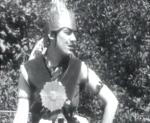
A specific segment of Dutch literature called Dutch Indies literature still exists and includes established authors, such as Louis Couperus, the writer of "The Hidden Force", taking the colonial era as an important source of inspiration. One of the great masterpieces of Dutch literature is the book " Max Havelaar" written by Multatuli in 1860.
The majority of Dutchmen that repatriated to the Netherlands after and during the Indonesian revolution are Indo (Eurasian), native to the islands of the Dutch East Indies. This relatively large Eurasian population had developed over a period of 400 years and were classified by colonial law as belonging to the European legal community. In Dutch they are referred to as 'Indische Nederlanders' (Indies Dutchmen) or more specifically as Indo (short for Indo-European).
Including their second generation descendants, Indos are currently the largest foreign-born group in the Netherlands. In 2008, the Dutch Census Buro for Statistics (CBS) registered 387,000 first and second generation Indos living in the Netherlands. Although considered fully assimilated into Dutch society, as the main ethnic minority in the Netherlands, these 'Repatriants' have played a pivotal role in introducing elements of Indonesian culture into Dutch mainstream culture.
Practically each town in the Netherlands will have a 'Toko' (Dutch Indonesian Shop) or Indonesian restaurant and many ' Pasar Malam' (Night market in Malay/Indonesian) fairs are organised throughout the year. Many Indonesian dishes and foodstuffs have become commonplace in the Netherlands. Rijsttafel a colonial culinary concept and dishes such as Nasi goreng and sateh are very popular in the Netherlands.


![Location of the Netherlands (dark green)– in Europe (light green & dark grey)– in the European Union (light green) — [Legend]](../../images/2173/217332.png)
